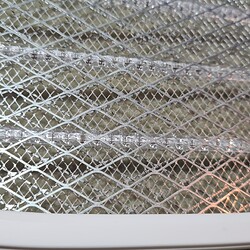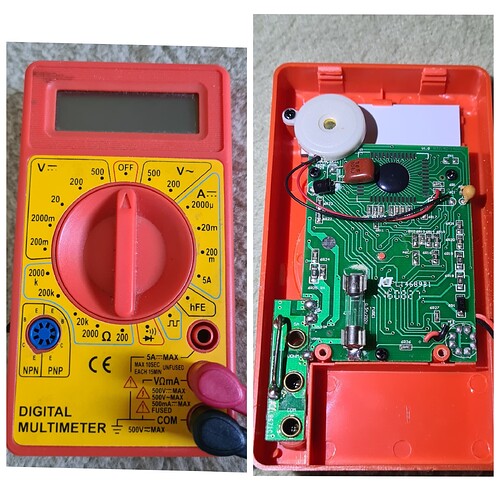My guess would be that you will not get a measurement that means much with any of your meters. As mentioned, the meter probably loads the zapper so much that the voltage goes down.
Fuses alone protect you from over current, not from over voltage.
And you can't make a strength comparison of mosquito killers by measuring the voltage with your multimeter.
You could try a high voltage multimeter probe like this:
High Voltage Probe
If you can find one that is cheap enough to satisfy your curiosity.
Super conversation starters at bars as well.
who cares what the voltage is?
you have seen a larger spark!
now test it with killing mosquitos…. as that is what is needed…
NB you are likely to damage your multimeter with >1000V. or at least lose the warranty…
See post #9
I tried with my secondary multimeter of 500v. Lamp show 273 volts temporary.
But can someone tell me why my recket cant measure voltage? I always got a spark with probes of multimeter.
If you look recket layer picture, shock begin when any of two "safety net" merged with single "electric grid", which grid is in middle of this two safety nets.
On lamp spark not applayed with multimeter, and can be measured. The recket did a spark, and cannot be measured.
On lamp spark is aplayed only with touching to wires with metal. But not with multimeter.
Is because is different instalation of net wires, or recket is realy stronger that much?
Btw my secondary multimeter is still ok, you can relax!
You really don't want to understand that you can't measure zapper voltage with normal multimeter. You will never get anything close to the voltage it shoots and eventually you destroy your multimeter.
I see you are determined to destroy all your meters.
@kmin friend, voltage doesn't have to be that precise. I got constant voltage on the lamp, steady, so it's enough to compare.
Recket may have that pulse like @jim-p say and because of that, we can't measure it.
And I want to know why between two probes of a multimeter, when touching positive and negative wires, got spark?
Shouldn't the probes be separated somehow to prevent that this doesn't happen?
For the UV lamp perhaps.. For the zapper no way.
Destroy all your meters and when you get tired with this project you can open a new thread about weird unexpected voltage measurements with them?
Hi, @danyCro
You got a spark because CURRENT flowed through your multimeter, your DMM has resistance so any voltage applied to it will cause a CURRENT to flow.
When you applied a higher voltage than the DMM was designed for the CURRENT flowing through the DMM and the VOLTAGE across it destroyed many of the components in the DMM.
Here is an advert for a Mosquito Swatter;
Note 3000V...
Much more than your DMM.
Tom.... ![]()
![]()
![]()
![]()
That makes sense.
And in the zepper lamp, I didnt got spark with DMM probes because the current, we assume, is within DMM range (<500v)?
You could make a voltage divider using high resistance/high voltage resistors and have a snowballs chance of getting a meaningful reading without damaging your voltmeter.
Maybe your electronics looks something like this inside.
In fact, if your DMM has the typical 10 megohm input resistance you could make a fairly usable voltage dividers out of capacitors. Some through hole ceramic capacitors used by hobbyists have a working voltage of 1kV. You could put 4 of those in series and make a voltage divider that would tolerate your 3-4 kV. You calculate the division just like series resistors. The value is not stable while charging or with very much current draw but maybe good enough with 10 megohm input resistance DMM.
I use this multimeter to test 500v 5A. See the PCB. There can't be installed those big capacitors?
I chose that one because black one don't have fuse, and newest UNI-T multimeter I don't want destroy.
Maybe you misunderstood. The images in Post #55 are of the inside of your tennis racket zapper. If you can expose the circuit board maybe you can safely measure the high voltage.
The voltage divider I am suggesting you build would be one like you would build to reduce the signal voltage to an Arduino for safe measurement except you would have to use components rated for the very high voltage you are dealing with.
There is no need to open up your DMM as the voltage divider would just be lying on your test bench and could easily be touched with your meter probes.
However, the best thing to do is just find another puzzle to work on.
In what post did you mention your Arduino board?
This is not an Arduino project. This is another one of @danyCro's adventures in tinkering.
Oh, I thought that you were sending me a picture of the DMM PCB, sorry.
Here is the PCB of the racket. It has 2 modes:
First mode: automatic function.
LED lights on Zapper is ON all the time.
Second mode: manual, hidden mode—without light. Zapper only activates when you hold the button.
That is one of the reasons why I want to check the voltage between modes. It seems that mode 2 stronger, but we will see.
Ah, okay. Then it looks like you can get at the high voltage wires without having to carefully probe the racket face itself. Then I recommend that you order some high voltage rated parts and build a voltage divider so you don't damage your DMMs.






